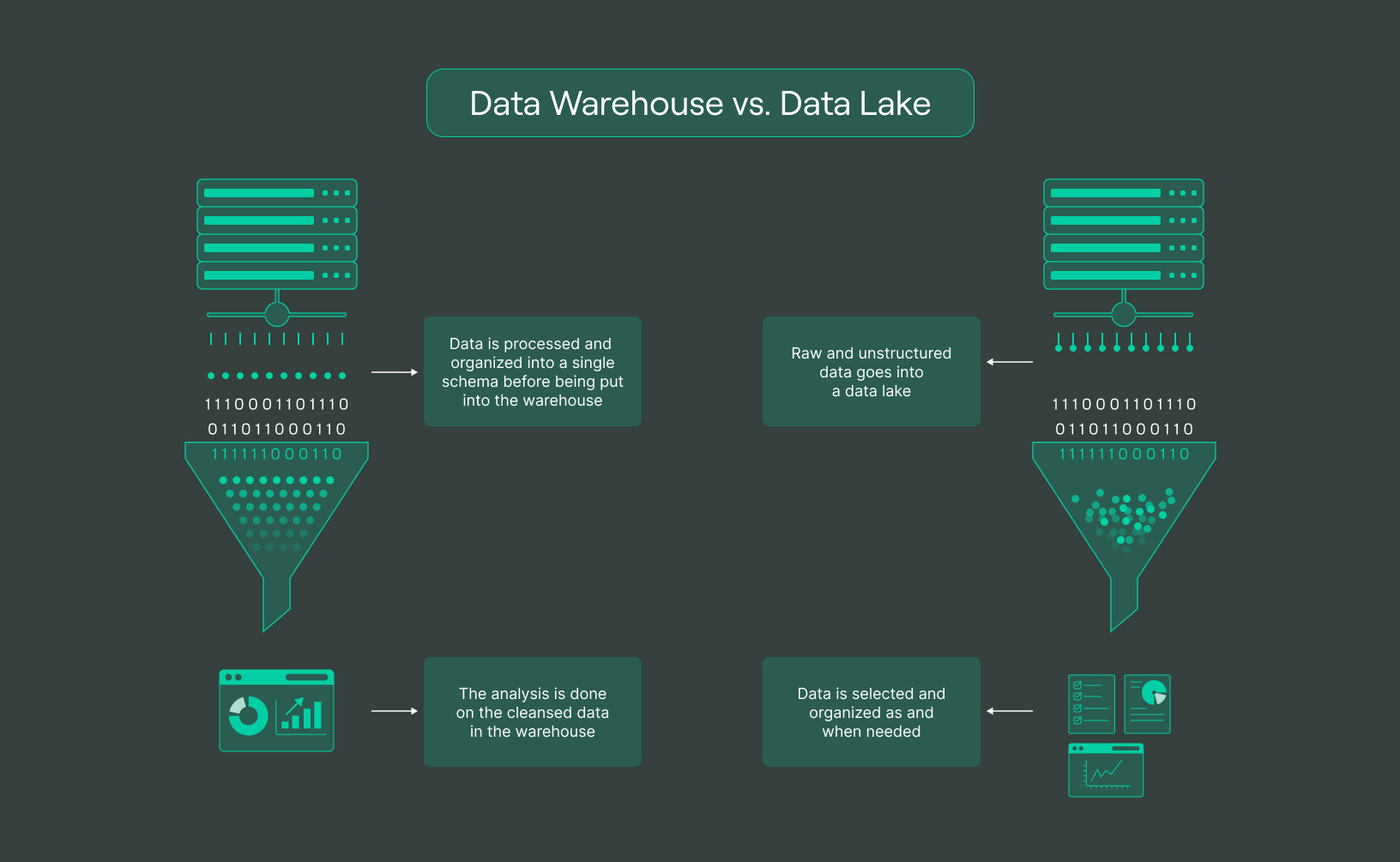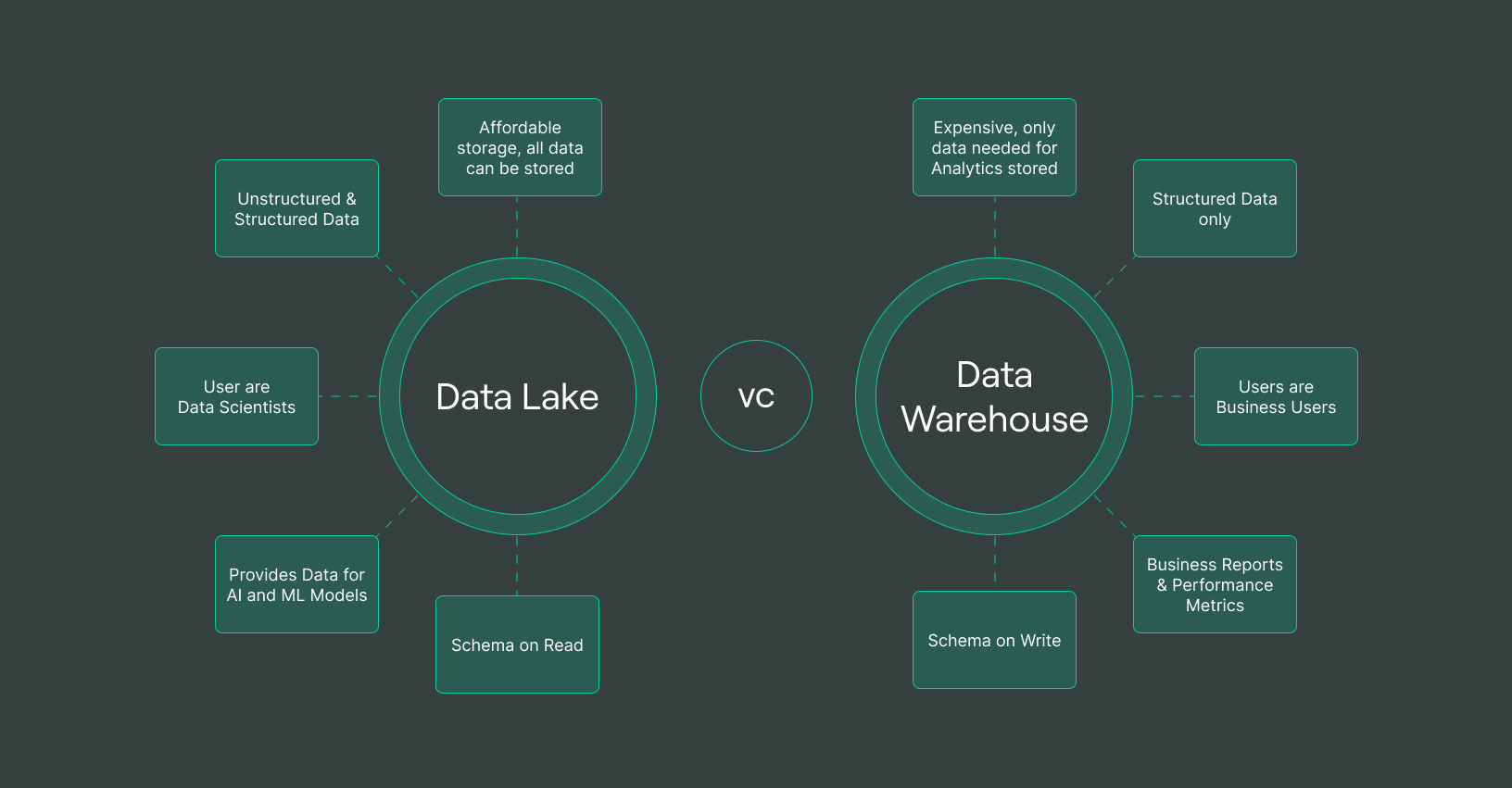
Data lakes vs. data warehouses: A deep dive into understanding the key differences
With every business operation comes the question, ‘which is right for me, data lakes vs data warehouses? ’ As these industries amass and preserve massive amounts of data, there is an urgent need for a mechanism for managing and analyzing that information efficiently. This has led to the widespread adoption of the two prominent options stated.
Both are useful when storing and processing large volumes of data; however, they differ in structure and intended applications. This article will provide a comprehensive guide to help you understand the significant differences between data lakes and data warehouses.
Database vs data warehouse vs data lake | What is the difference?
In this article, we’ll talk about:
- What is data lake?
- What is data warehouse?
- Why understanding the differences between the two is important
- Key differences between data lake and data warehouse
- Data lake vs data warehouse: A comparison table
- Are there any similarities between data lake and data warehouse?
- How DoubleCloud helps to work with data warehouse and data lakes?
- Data lake vs data warehouse: Which is right for me?
What is data lake?

A data lake is a centralized repository designed to store, process, and secure large amounts of structured, semi-structured, and unstructured data. It is known to store raw data in its original form and process any kind of data, regardless of its size limits.
Data lakes support enterprises, allowing them to access data on a scalable and secure platform that will enable them to ingest data from any system at any speed, regardless of whether the data originates from cloud, on-premises, or edge-computing systems.
Data lake can save any volume or type of data, processing and analyzing data in real-time or batch mode, using Python, R, SQL, or any other language, analytics applications, or third-party data.
With data pipeline, data can be moved from one system to another for storage and further handling.
Read more about data lake in our article — What is Data Lake? A Beginner’s Guide for Everyone
Examples
Many organizations in the modern world depend on cloud storage services such as Google Cloud Storage, Azure Data lake, and Amazon S3. They can also use a distributed file system like Apache Hadoop distributed file system (HDFS) to manage their data. The popularity of the Data lake concept has increased in academic circles due to the growing need for effective data management and analysis.
An example is the Personal DataLake at Cardiff University, a new type of data lake designed to manage the big data of each user by providing a centralized location to collect, organize, and share personal data.
Sadly, Newer versions, such as Hadoop 1.0, had limited capabilities with its batch-oriented processing (Map Reduce) and were the only associated processing paradigm. Interacting with the data lake required expertise in Java with Map Reduce, and higher-level tools like Apache Pig, Apache Spark, and Apache Hive, which were initially batch-oriented. As a result, businesses had to invest heavily in training their personnel to use this system effectively.
What is data warehouse?
A data warehouse is a powerful tool businesses use to enhance their decision-making processes by analyzing vast amounts of organizational data. It is specifically designed to support business intelligence (BI) activities by consolidating data from multiple sources. This refined data is often used to gain insights into the company’s business operations and historical performance, making it a critical asset for data scientists and business analysts.
They store large volumes of current and historical data, which can be used to create accurate and reliable reports. These reports give business leaders a comprehensive understanding of their company’s performance. By using these insights to drive decisions, companies can better allocate resources and identify areas for improvement.
Unlike data swamps, they are optimized for analytical tasks and designed to make data analysis easier. They provide a consistent, structured view of data that anyone in the organization can access. As a result, these tools are often referred to as the “single source of truth” for an organization’s data.
** Read more about data warehouse in our article — What is data warehouses: Business Benefits and Key Concepts**
Examples
Analyzing customer and market trends is critical for investment and insurance firms, and data warehousing provides a valuable tool for these analyses. Let’s look at how businesses can leverage this tool in their day-to-day operations.
Data warehouse technologies are essential for marketing and distribution purposes in retail chains. These chains can find items through data marts, analyze customer buying patterns, and evaluate pricing policies. They also use data warehouse models to meet their BI and forecasting needs.
The healthcare industry uses data warehouse concepts to share data with insurance providers, generate treatment reports, and facilitate research in medical units. With the latest treatment information needed to save lives, enterprise data warehouses play a crucial role in healthcare systems.
Why understanding the differences between the two is important

Data lakes vs. data warehouses are popular options for managing big data, but they have distinct differences. While a data lake is a vast repository of raw, undefined and unprocessed data, a data warehouse stores structured and filtered data that has already been processed for the right reason.
Recently, a new data management architecture called a “data lakehouse” has emerged, which combines the flexibility of a data lake with the management capabilities of a data warehouse.
While both tools may seem similar at first glance, they differ significantly. They serve various purposes and require many optimization strategies. What works for one organization might be the reverse for another, making it essential to understand their differences.
Key differences between data lake and data warehouse
It is common for organizations to apply both a data lake and a data warehouse in catering to their data storage needs. More so, some businesses opt for a data lakehouse by combining key benefits and features of both to leverage each benefit.
To get more data storage solutions, it’s essential to understand the differences between data lake vs. data warehouse solutions and how they can complement each other.
Data model
Regarding data models, data lakes vs. data warehouses differ significantly. Data is stored in its original format in a data lake, including structured, semi-structured, or unstructured data. In contrast, a data warehouse stores data in a highly structured format with a predefined schema and data types.
This difference in data model gives lakes the advantage of quick and easy ingestion of larger storage capacity without extensive data modeling or transformation. With a data warehouse, on the other hand, data needs to be structured and processed before it can be loaded into the warehouse.
Data sources
Both platforms have similar capabilities of storing data from multiple sources. However, a key difference is that data warehouses require a pre-defined schema and only allow structured data to be stored.
On the other hand, lakes can store semi-structured and unstructured data, such as sensor data, social media data, and web server logs, without needing a pre-defined schema.
Data storage
Comparing a Data lake vs. Data Warehouse, a data lake storage is a massive storage facility that keeps vast amounts of raw data in its original form until needed. Unlike data warehouses, no strict rules or limits govern data storage in a data lake, making it possible to store structured, unstructured, and semi-structured data from various sources.
In contrast, a data warehouse stores large amounts of structured data processed and organized for a specific purpose. This type of data is typically collected from various internal and external sources within an organization and may include critical insights like customer data, product information, or employee records.
Data processing
Data warehouse technology is designed to process data in a structured way. This involves using specialized ETL tools to extract, transform, and load data into a structured format, making it easy for businesses to analyze and report on the processed data. Generally, data warehouses are best suited for batch processing of data.
However, data lakes work differently. They store data in its raw form without any transformation or modeling. This unique feature enables faster and more flexible data processing, making it the ideal for real-time data processing, analytics, machine learning, and other advanced analytics applications.
Cost
Data lakes are cost-effective solutions when compared to data warehouses. By accepting any type of data, whether structured, semi-structured, or unstructured, data lake solutions offer greater flexibility and scalability without the need to conform to a fixed schema.
Without data filtration and structuring, data lakes are ideal for storing massive data. This cost-saving feature distinguishes a data lake from a data warehouse, which can be more expensive due to the required data filtration and structuring processes.
However, data lakes trade cost savings because structured data stored in a data warehouse can be analyzed more quickly and efficiently than data stored in a data lake.
Read more about data warehouse in our article — How Do Data Warehouses Save Businesses Money?
Agility
Data lakes are designed for agility and ease of use, enabling data to be added and stored without needing a fixed schema. This makes them more flexible, allowing data scientists and developers to configure data models and use advanced tools for big data analytics.
Data warehouses, on the other hand, are structured and less adaptable. They typically have a “read-only” format that allows data analysts to extract data or insights from historical, pre-processed data. The rigidity of their data structure makes them less flexible, and any changes or modifications require a significant effort.
Data quality
Data warehouses store pre-curated and clean data, while data lakes can store raw data and less structured. This means that data quality is higher in data warehouses than in data lakes.
Data governance
Data warehouses have established processes and procedures for maintaining the quality of their data, while data lakes often lack such procedures. This makes data governance more robust in data warehouses than in lakes.
Time-to-value
Since data warehouses store pre-curated and clean data, they typically require less time to analyze and extract value from it. On the other hand, data lake store raw and unstructured data, which can take more time to prepare before any valuable insights can be drawn from them.
Scalability
Data warehouses are usually limited in scalability due to their reliance on a single hardware architecture. In contrast, lakes can easily scale up by adding additional hardware and software resources.
Use cases
Data warehouses are well-suited for traditional business intelligence tasks like reporting and analytics. Data lakes can be used for various tasks, including machine learning, text analysis, streaming analytics, etc.
Processing
Data warehouses use relational database technologies for processing and storage, while lakes rely on distributed storage systems such as Hadoop or Apache Spark.
Data lake vs data warehouses: A comparison table
|
Difference |
Data warehouse |
Data lake |
|
Data Model |
Structured data |
Structured, semi-structured, unstructured data |
|
Data Sources |
Relational databases, ERP systems, CRM systems, etc. |
Any source, including IoT devices, social media, etc. |
|
Data Storage |
Structured, curated, cleansed, filtered, aggregated data |
Raw data in its native format |
|
Data Processing |
OLAP, data analysis and reporting |
Machine learning, advanced analytics, and big data tools |
|
Cost |
High |
Lower than data warehouses |
|
Agility |
Less agile due to fixed schema and structure |
Highly agile, flexible, and scalable |
|
Data Quality |
High, as data is processed and curated for specific use |
Can be low due to the raw form of data |
|
Data Governance |
Centralized, strict governance policies and procedures |
Decentralized, flexible governance |
|
Time-to-Value |
Longer due to ETL processes and data processing |
Faster due to less processing and immediate access |
|
Scalability |
Vertical scaling |
Both vertical and horizontal scaling |
|
Use Cases |
Operational decision-making, historical data analysis |
Machine learning, advanced analytics, IoT, and big data storage space |
|
Processing |
SQL, ETL, BI, reporting tools |
Machine learning, advanced analytics, and big data tools |
|
Tools |
Data modeling, ETL, BI, reporting tools |
Machine learning, advanced analytics, and big data technologies |
Are there any similarities between data lake and data warehouse?
While data lake vs. data warehouse have different structures and purposes, they share some similarities, some of which are;
These data systems act as data silos as they store large amounts of data from multiple sources.
They are both designed to support querying and analysis of data, although data warehouses are optimized for this purpose.
They can store structured and unstructured data, although data lakes are more flexible in this regard.
They can be used to support business intelligence and analytics.
How DoubleCloud helps to work with data warehouse and data lakes?
DoubleCloud is a cloud management platform that provides customers with innovative solutions to automate and analyze infrastructure on a cloud scale. Its unique features offer cost-effective solutions to companies that manage data in warehouses and lakes. DoubleCloud is built on integrated and open-source technologies that allow for creating online analytical processing that delivers results in sub-seconds.
With DoubleCloud, companies can easily consolidate data from multiple sources into a single data warehouse or data lake, providing an efficient and cost-effective way to manage and analyze data. This eliminates the need for expensive infrastructure and simplifies the data management process, making it easier to derive insights and make data-driven decisions.
Data lake vs data warehouse: Which is right for me?
When choosing between a data warehouse and a data lake, it’s essential to understand the specific needs of your business. A data warehouse is ideal for companies that require structured data for analysis and reporting. This type of system extracts data from multiple sources, transforms it, and loads it into a structured format, making it easier to analyze and give reports on. Data warehouses are great for processing large amounts of current and historical data in batches.
On the other hand, data lakes are a better option for businesses that require flexibility and agility in processing large amounts of raw, unstructured data. This type of system stores data in its native format, allowing for faster and more flexible processing. Data lakes are ideal for real-time data processing and advanced analytics apps like machine learning.
When deciding which system to use, you must consider several factors, including the type of data you need to store, how often data is updated, the analytics you plan to perform, and your budget. By considering all of these factors, you can make an educative decision that meets the uniqueness of your business.
Frequently asked questions (FAQ)
Should I use data warehouse or data lake?
Should I use data warehouse or data lake?
Data warehouse architecture is the way to go regarding query data performance, as they are designed to provide the fastest results. Business users prefer data warehouses because it enables them to generate reports more efficiently.
On the other hand, data lake architecture prioritizes cost and storage volume over query performance.
Can a data lake replace data warehouse?
Can a data lake replace data warehouse?
Is ETL a data lake?
Is ETL a data lake?
What are some use cases where a data lake is preferred over a data warehouse?
What are some use cases where a data lake is preferred over a data warehouse?
What are some use cases where a data warehouse is preferred over a data lake?
What are some use cases where a data warehouse is preferred over a data lake?
Start your trial today



